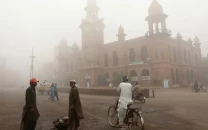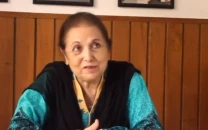Traffic pollution: By 2030 twin cities will be in a mess if we don’t say ‘bus’
In 20 years the cities will have about 34m vehicles pumping out 24m tonnes of Nitrogen oxides alone in pollution.

These predictions were made by a team of researchers, Rabia Shabbir and Sheikh Saeed Ahmad, of the department of Environmental Sciences at Fatima Jinnah Women University, Rawalpindi. Their study was published in May 2010 in the journal Energy and was titled ‘Monitoring urban transport air pollution and energy demand in Rawalpindi and Islamabad using [the] leap model’.
“When we looked at what our situation would be in 20 to 25 years, we were astonished to see that Pakistan would have nothing left, not in the energy sector nor in the environment,” said Ahmad while talking to The Express Tribune. “Our energy policy needs to be revised when it comes to coal, fossil fuels, alternative energy.” While wind and atomic energy projects exist on paper, very little has actually started working.
The duo did, however, focus on solutions. For example, in two decades, if we don’t make a change somewhere, the twin cities will be using 120 million litres of petrol. Shabbir and Ahmad estimated, however, that this could be kept to 89 million litres if we switched to using more buses. Only 18 million tonnes of the polluting Nitrogen oxides would be emitted then.
The team took government data from the year 2000 and used LEAP (the Long-Range Energy Alternatives Planning System) model to estimate total demand for fuel and vehicular emissions up till the year 2030. LEAP has been successfully used for similar projects in 150 countries.
They also collected data on three pollutants: Nitrogen oxides, particulate matter and Sulfur dioxide. The scenario that emerged was grim. In 2000, Rawalpindi had more registered vehicles (115,700) than Islamabad (11,400). Combined, they used 362,600 liters of energy and produced 93,620 tonnes of pollution.
The forecasts factored in that Islamabad and Rawalpindi have about 1.9 million people and the population grows about four times more than other cities each year. According to the researchers, as cities burgeon and strain at their seams, haphazard growth of homes and offices means that people make more and more trips per person to get around.
Shabbir and Ahmad then came up with three different scenarios to study the impact of different policies that would bring down the use of fuel and pollution. Either the government and residents and businesses of the two cities could continue at the same rate. Or they could work together to get vehicles off the roads and use more public transport. They could also switch from petrol to using natural gas. In some respects, this has been slowly happening.
The growth of the CNG business in Pakistan is “impressive” and we have become the leading user of the gas in Asia and the third largest in the world after Argentina and Brazil.
Even if any of the three options are used, the team found that they would bring the need for fuel and pollution down by a minimum of 15 per cent. Either we have less cars on the road, switch to natural gas or go for public transport. The numbers showed that using more public transport would have the most impact.
The government’s challenge now is to restrain private transport (cars and motorcycles) and persuade people to use public transport, especially buses, as more people can fit in them.
The number of motor vehicles in Pakistan doubled from 2.7 million in 1990 to 5.5 million in 2005. In fact, road traffic has outstripped the economy. A decade ago, about 135 million people lived in Pakistan with roughly a third living in cities.
Dr Abid Qayyum Sulehri of the Sustainable Development Policy Institute also pitched a mass transit system. “It is the right time to work on long-term projects to overcome the worst economic crisis in the history of the country,” he said.
In Singapore and Shanghai, for example, the government has capped on the numbers of vehicles that can register annually. The problem in Pakistan is that while new cars keep coming onto the roads, the rest of the vehicle fleet is old and broken down. As a result roads are worn down and there are serious levels of air and noise pollution.
Zafarullah Khan of the Centre for Civic Education, Pakistan, points out that the existing public transport system needs to be improved. “The government could not even ensure transport for schools which is why the private use of vehicles has increased the consumption of fuel,” he said.
Fatima Jinnah Women University decided to undertake this study for the benefit of policymakers. An indication of the government’s willingness to change became apparent to Shabbir and Ahmad who found that government agencies were not happy to give them data. “Perhaps if we got the actual data the real situation would have been even more alarming,” Ahmad remarked wryly.
Published in The Express Tribune, January 13th, 2011.



















COMMENTS
Comments are moderated and generally will be posted if they are on-topic and not abusive.
For more information, please see our Comments FAQ